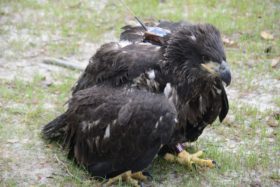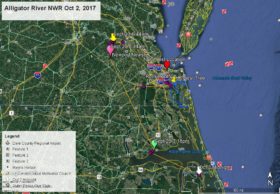NBG Eagle Cam In Operation
Camera down at NBG
January 17, 2010Azalea Stays at Alligator River NWR Jan 12-18
January 19, 2010
Categories
A power surge on Sunday afternoon knocked out the router and cut off the camera. All now back up and running. Live eagle cam is at www.WVEC.com – then click on eagle picture on home page or use this link http://www.wvec.com/marketplace/microsite-content/eagle-cam.html




5 Comments
Reese, I read that it take 5 to 10 days after a successful mating for an egg to be laid. So, if eggs are laid every 3 or 4 days, then there must be more than one forming at a time. Can the female tell that there is a bun or two or three in the oven so she will stop mating? Or is there some other way that eagle pairs control how many eggs they have? Thanks.
Chris – The sperm of the male can remain active for up to seven days. It is a lottery as to wether a sperm will find an ova (female egg). Once it does it has to find the oviduct. It then takes about 24 hours for the egg to form, so only one egg at a time is forming. It is extrenely rare for more than 3 eggs to be produced. As to why that is, I am not sure but will try to find out.
How interesting! Hope this pair will again have three eggs. Can’t wait for the first egg to arrive!
reese — rare for more than 3 eggs- ? she produced 5 when Buddy was sole survivor right ?
Rose – You are correct. However, the difference is that the NBG pair layed a clutch of two eggs which were addled when they abandoned the nest and eggs. They then recycled, mated again and layed three eggs in a second clutch. The female crushed the first two of these eggs when she was startled at night by a Great Horned Owl. The third egg hatched and is the eagle (known as Buddy) that is at the Wildlife Center of Virginia.
Reese